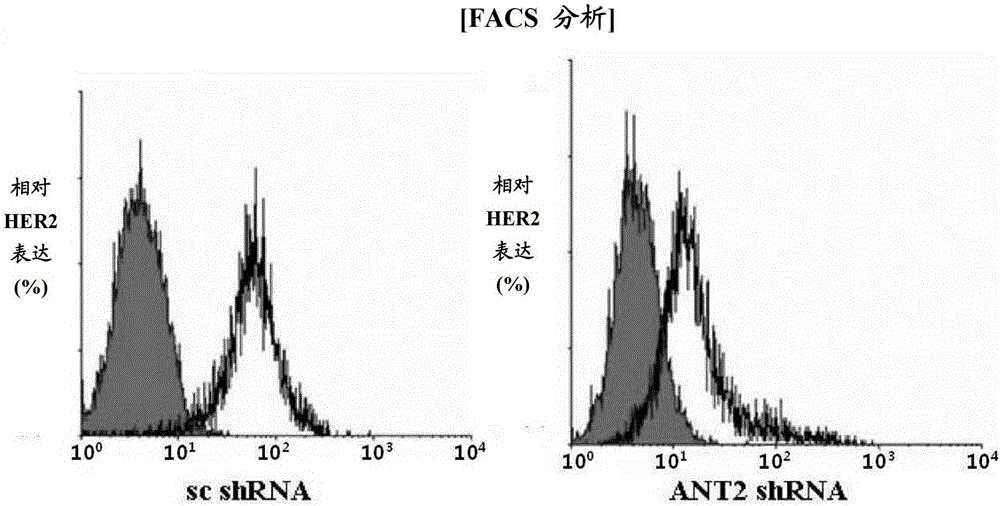Method for treating breast cancer by reducing expression of adenine nucleotide transporter 2 mRNA
An adenine nucleotide and transporter technology, applied in the field of breast cancer treatment, can solve problems such as side effects and achieve the effect of overcoming tolerance
- Summary
- Abstract
- Description
- Claims
- Application Information
AI Technical Summary
Problems solved by technology
Method used
Image
Examples
Embodiment 1
[0105] Example 1: Effect of ANT2shRNA on HER2 / neu expression
[0106] The present inventors found that the introduction of ANT2 shRNA reduced the expression level of HER2 / neu on the surface of the breast cancer cell line SK-BR3 as measured by FACS (flow cytometry and cell sorting).
[0107] Lipo-fectamine TM 2000 (Invitrogen, a non-viral delivery system) was used to introduce ANT2 shRNA into the breast cancer cell line SK-BR3. In this regard, Lipofectamine TM The positively charged hydrophilic component of 2000 interacts with the negatively charged shRNA to form a complex. This complex fuses with the cell membrane, thereby delivering the shRNA into the cell.
[0108] For FACS analysis, HER2 / neu expressed on the cell surface was conjugated to an antibody [primary antibody: anti-human HER2 / neu antibody (Santa Cruz Biotechnology, Heidelberg, Germany)] followed by secondary antibody (FITC-conjugated anti-rabbit-IgG (SantaCruz Biotechnology, Heidelberg, Germany)) reacted. Beca...
Embodiment 2
[0113] Example 2: Effect of ANT2shRNA on Akt activity
[0114] In breast cancer cell line SK-BR3, highly expressed HER2 / neu activates Akt. Activated Akt is known in the art to be involved in breast cancer cell survival mechanisms and in breast cancer cell migration and invasion into other tissues. Activation of Akt can be determined by phosphorylation of tyrosine residues.
[0115] Activated Akt (phosphorylated) was quantified after ANT2 shRNA transfection into the human breast cancer cell line SK-BR3 [anti-Akt antibody and anti-phospho-Akt antibody (CellsignalingTech., Beverly, MA)]. Higher Akt activity maintained in breast cancer cell lines was reduced by introduction of ANT2 shRNA. 17-AAG, known to inhibit HSP90 and thus the HER2 / neu-mediated Akt signal transduction pathway, was used as a positive control ( image 3 A).
[0116] In addition, inhibition of Akt by ANT2 shRNA was determined by another experiment. The activity of phospho-Akt was decreased after knockdown o...
Embodiment 3
[0119] Example 3: Effect of ANT2shRNA on VEGF production
[0120] In the present invention, it was found that the introduction of ANT2 shRNA into the human breast cancer cell line SK-BR3 resulted in a decrease in Akt activity (inhibition of the PI3K / Akt signaling pathway), resulting in downregulation of VEGF, which is involved in angiogenesis around tumor cells.
[0121] Specifically, cells transfected with ANT2 shRNA were cultured for 24 hours, followed by isolation of total RNA. From the mRNA therein, cDNA was synthesized by reverse transcription with oligo-dT. The expression of VEGF was analyzed using primers specific for VEGF (vascular endothelial growth factor).
[0122] Such as Figure 4 As shown in A, knockdown of ANT2 by shRNA in the breast cancer cell line SK-BR3 was observed to decrease mRNA levels of VEGF, which is involved in angiogenesis, as measured by RT-PCR.
[0123] In addition, decreased intracellular VEGF protein levels were observed using FACS (flow cyto...
PUM
 Login to View More
Login to View More Abstract
Description
Claims
Application Information
 Login to View More
Login to View More - R&D
- Intellectual Property
- Life Sciences
- Materials
- Tech Scout
- Unparalleled Data Quality
- Higher Quality Content
- 60% Fewer Hallucinations
Browse by: Latest US Patents, China's latest patents, Technical Efficacy Thesaurus, Application Domain, Technology Topic, Popular Technical Reports.
© 2025 PatSnap. All rights reserved.Legal|Privacy policy|Modern Slavery Act Transparency Statement|Sitemap|About US| Contact US: help@patsnap.com



